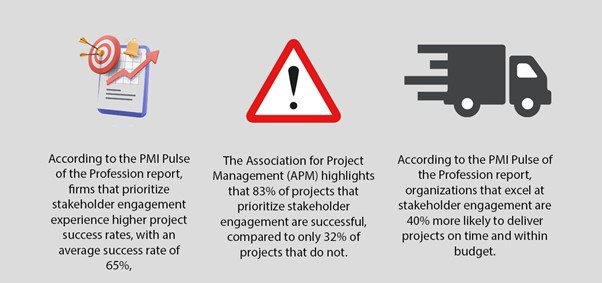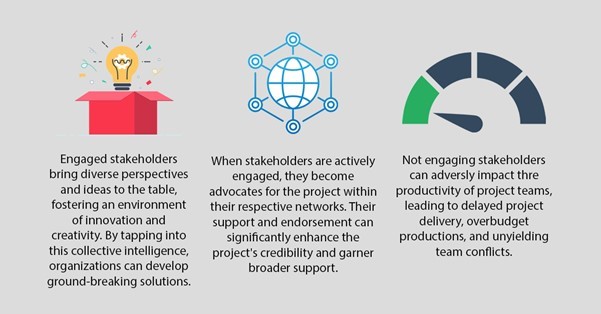
In today's dynamic and interconnected business landscape, stakeholder engagement has emerged as a pivotal factor for success. Organizations across industries are increasingly recognizing the value of actively involving their stakeholders in decision-making processes to drive positive outcomes. Stakeholder engagement refers to the strategic and systematic approach of identifying, communicating with, and involving individuals or groups who have a vested interest in a project or organization. But why have stakeholder engagement plans become so crucial in modern organizational scenarios? The answer is simple: an inclusive and innovative workspace.
A robust stakeholder engagement plan is a key driver of business success, fostering collaboration, transparency, and effective decision-making. By actively managing project stakeholder engagement throughout the project lifecycle, you can benefit from enhanced project success rates, improved risk management, and a stronger brand reputation. Implementing an effective stakeholder engagement strategy not only fosters a collaborative and inclusive environment but also yields tangible benefits for businesses.

Why a Stakeholder Engagement Plan Is Vital
What is a stakeholder engagement plan? When you plan stakeholder engagement, it holds immense importance in the success of any project or initiative. It goes beyond merely identifying and involving individuals or groups affected by the project; it is about building meaningful relationships and fostering open communication throughout the project's lifecycle. The significance of engagement strategy for stakeholders can be observed in several key areas:
- Project Alignment and Buy-In: Planning stakeholder management early in the project allows you to implement their input and alignment with the project's goals and objectives. When stakeholders are involved from the outset, they are more likely to understand and support the project's purpose, leading to greater buy-in and commitment.
- Risk Management: Stakeholders often possess valuable insights into potential risks and challenges that may impact the project. By actively planning a stakeholder engagement strategy, you can identify and address risks early, reducing the likelihood of costly disruptions and delays.
- Decision-Making: Stakeholder engagement in project management throughout the project gives project managers a broader perspective on various issues and challenges. This diversity of viewpoints enables informed decision-making, leading to better outcomes and solutions.
- Resource Allocation and Support: An effective stakeholder engagement model assists in identifying resource needs and garnering support for the project. Engaged stakeholders are more likely to advocate for necessary resources and provide the support needed to overcome obstacles.
- Project Adaptability and Flexibility: Project management stakeholder engagement facilitates ongoing feedback and evaluation of the project's progress. This constant dialogue allows for timely adjustments and course corrections, ensuring that the project remains aligned with evolving business needs and market conditions.
"By treating stakeholder engagement as a strategic priority, we've built stronger relationships and gained valuable insights."
Sarah Johnson, CIO of Innovate Tech Solutions

Benefits of the Stakeholder Engagement Plan
- Enhanced Project Success Rates: According to a recent PMI Pulse of the Profession report, organizations prioritizing stakeholder management and engagement experience higher project success rates, with an average success rate of 65% compared to 35% for organizations with poor engagement practices.
- Strengthened Brand Reputation: Stakeholders in planning demonstrate a commitment to transparency and ethical practices, boosting an organization's reputation and credibility in the eyes of both customers and investors.
- Increased Innovation and Creativity: What is stakeholder engagement plan? Engaged stakeholders bring diverse perspectives and ideas to the table, fostering an environment of innovation and creativity. By tapping into this collective intelligence, organizations can develop ground-breaking solutions and stay ahead of their competitors.
- Stakeholder Advocacy and Support: When stakeholders are actively engaged, they become advocates for the project within their respective networks. Their support and endorsement can significantly enhance the project's credibility and garner broader support.
"By actively involving stakeholders in decision-making, we've gained valuable insights and fostered a culture of collaboration that fuels project success."
Rachel Turner, CIO of Collaborate Tech Solutions
Ways to Improve Stakeholder Engagement
- Identify Key Stakeholders: Conduct a thorough stakeholder analysis to identify all relevant individuals and groups who may be affected by or have an impact on the project. Prioritize their needs and expectations in the stakeholder engagement strategy.
- Foster Open Communication: Establish clear communication channels to facilitate open and honest dialogue between the organization and its stakeholders. Leverage technology tools, like project management software, to streamline communication.
- Tailor Engagement Approaches: The Association for Project Management (APM) highlights that 83% of projects that invest in planning stakeholder management are successful, compared to only 32% of projects that do not. Recognize that different stakeholders have unique interests and communication preferences. Tailor engagement strategies to address the specific needs of each group.
- Regular Engagement Activities: Regularly update stakeholders' engagement plan throughout the project lifecycle, from planning to execution and beyond. Keep stakeholders informed about project progress, changes, and results.
- Provide Opportunities for Participation: According to the PMI Pulse of the Profession report, organizations that excel at stakeholder plans are 40% more likely to deliver projects on time and within budget. Actively involve stakeholders in decision-making, allowing them to contribute ideas, feedback, and suggestions.
- Address Stakeholder Concerns: Transform Magazine's report states that organizations prioritizing genuine stakeholder engagement strategies have a 50% higher likelihood of successfully achieving their transformational goals. Address concerns and feedback from stakeholders in a timely and transparent manner. Demonstrate a commitment to resolving issues and meeting their expectations.
- Measure Engagement Effectiveness: Implement metrics to assess the success of stakeholder engagement in project management. Use feedback to refine engagement strategies for stakeholders and improve outcomes.
A stakeholder engagement plan leads to increased innovation and creativity as diverse viewpoints drive ground-breaking solutions. Stakeholder advocacy and support become a valuable asset, enhancing the project's credibility and garnering broader backing. To plan stakeholder engagement, organizations should identify key stakeholders and tailor engagement approaches to their unique interests and preferences. Open and regular communication, coupled with opportunities for participation, ensures stakeholders are involved in decision-making processes. Addressing stakeholder concerns in a timely and transparent manner demonstrates a commitment to meeting their expectations.
By measuring the effectiveness of your stakeholder engagement model, you can continually refine your strategies and achieve even greater project success. Embracing a robust stakeholder engagement plan as a strategic priority empowers your business to thrive in the ever-evolving business landscape and create an inclusive and innovative workspace.
Overall, stakeholder management and engagement have evolved into a pivotal factor that drives successful project outcomes, fosters collaboration, and cultivates an environment where businesses can adapt, succeed, and lead in their respective industries. Organizations that prioritize their stakeholder engagement strategy as a core aspect of their project management practices are well-positioned to excel in the competitive and dynamic business world. Through active involvement, genuine communication, and collaborative decision-making, businesses can truly harness the power of stakeholder engagement to achieve remarkable achievements and pave the way for a prosperous future.
TrueProject can significantly improve stakeholder engagement by enhancing communication, collaboration, and transparency throughout the project lifecycle. It provides a centralized platform where all stakeholders, including team members, clients, vendors, and sponsors, can access project information, updates, and relevant documents. Besides, it also allows stakeholders to receive real-time updates on project progress, milestones achieved, and any changes in the project plan. This ensures that stakeholders are informed promptly, enabling them to provide timely feedback and make necessary decisions.
More information on TrueProject can be found at: TrueProjectInsight.com
 About the Author
About the Author
Dale Malcolm is the Director of Trueproject Customer Success, with over 30 years of experience spanning software development, consulting, and business process re-engineering across multiple industries and countries. He has excelled in roles ranging from lead architect for data collection systems to database architect for telecom software and has led various teams in implementing cost-effective and efficient IT solutions, including ERP and enterprise architecture practices.
Endnotes
- Ulery, Adam. "5 Ways Agile Teams Can Engage Stakeholders.” AgileThought, April 27, 2023.
- Harrin, Elizabeth. Thinking differently about stakeholder engagement: six key tips." The Association for Project Management (APM). September 22, 2020. https://www.apm.org.uk/blog/thinking-differently-about-stakeholder-engagement-six-key-tips/
- Transform magazine. "Genuine transformation requires genuine stakeholder engagement.” November 22, 2022. https://www.transformmagazine.net/articles/2022/genuine-transformation-requires-genuine-stakeholder-engagement/
- Project Management Institute (PMI). "Pulse of the Profession." https://www.pmi.org/learning/thought-leadership/pulse





